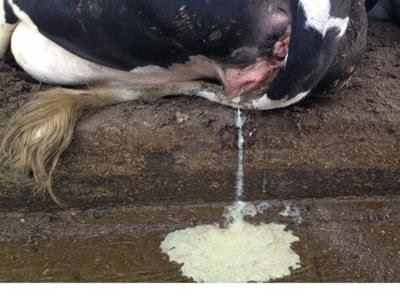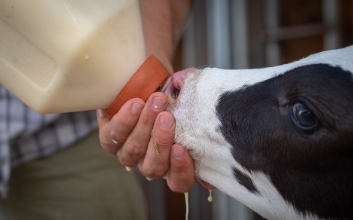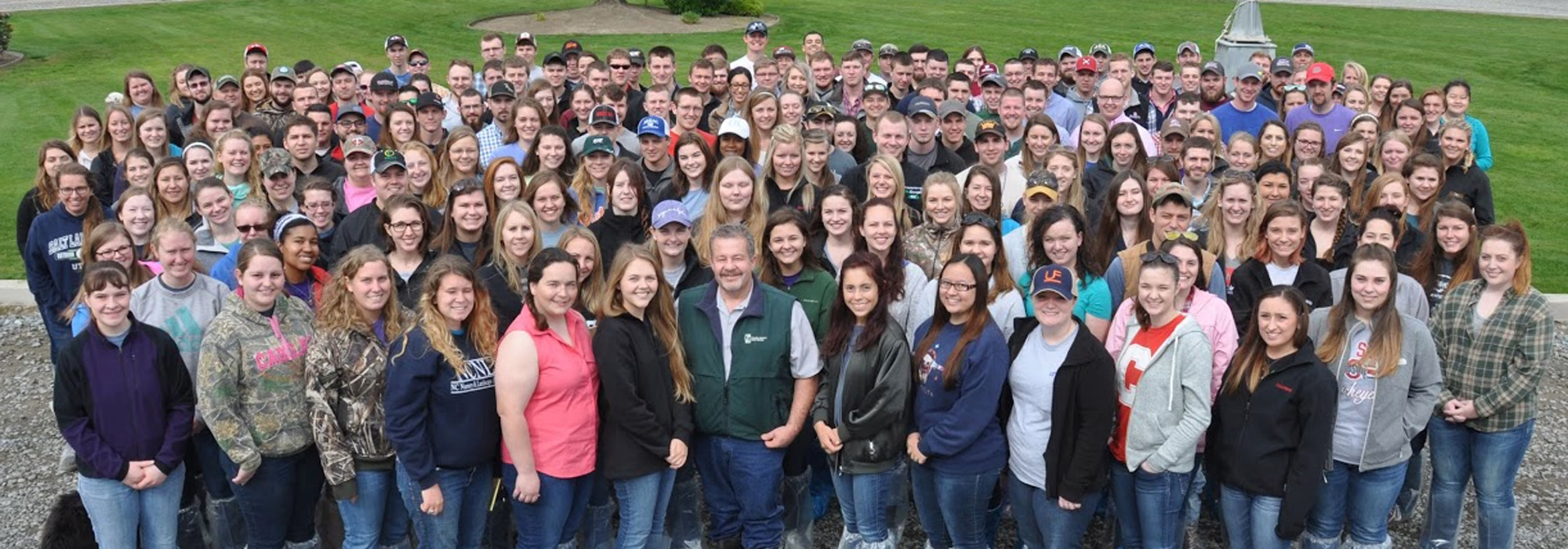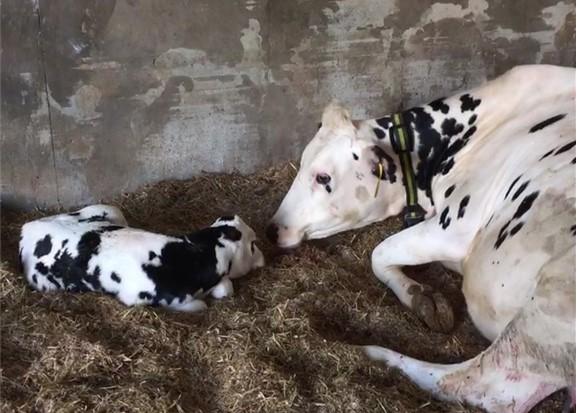Learn how purulent vaginal discharge affects your dairy farm’s profits. Are hidden costs hurting your milk production and herd health?
Summary:
Purulent vaginal discharge (PVD) significantly impacts dairy profitability, as evidenced by a U.S. study involving over 11,000 cows. These cows exhibited reduced milk production—241 kg less over 305 days—lower pregnancy rates at 70.7% versus 78.9% and higher culling rates of 34.6% compared to 27.2%, leading to a profit decrease of approximately $202 per cow. PVD affects 20% of dairy herds, hurting individual farm profits and the industry overall, as it diminishes milk sales and cow value and necessitates higher costs for replacements and reproductive management. It’s associated with other uterine diseases, delays ovarian cycles, and affects artificial insemination success, increasing culling likelihood. Dairy managers must understand and mitigate PVD’s effects to safeguard herd health and profitability.
Key Takeaways:
- PVD significantly affects the profitability of dairy farms through reduced milk production, impaired reproductive performance, and increased culling.
- The cost associated with PVD is extensive, with a mean loss of $202 per affected cow, impacting small-scale and large-scale dairy operations.
- Stochastic analysis reveals that the financial loss due to PVD can vary, ranging from $152 to $265, depending on different factors and scenarios.
- Key contributors to economic loss include reduced milk yield, increased replacement costs, and decreased residual cow value.
- Preventative strategies and effective management of PVD could lead to substantial economic savings and improved overall herd health.
- The study underscores the necessity for increased awareness and proactive measures to manage dairy cattle’s reproductive health issues.

Think about a situation where something as ordinary as a cow’s discharge could quietly harm your dairy farm’s profitability, going unnoticed by many. This is the reality of purulent vaginal discharge (PVD) in dairy cows. PVD is often ignored, but it can cause serious troubles for the productivity and finances in herds. Recent studies, such as The economic impact of purulent vaginal discharge in dairy herds within a single lactation, published in the Journal of Dairy Science, reveal that PVD can cost an average of $202 per affected cow. This finding shows how PVD affects milk output, pregnancy rates, and culling choices, all crucial factors directly impacting a farm’s profits.
While PVD is a hidden threat to dairy farm profits, it is not an insurmountable challenge. With increased awareness and better management strategies, PVD can be effectively prevented, empowering dairy farmers to control their herds’ health and profitability.
As we examine the study’s findings more closely, we uncover the complex economic issues PVD causes, testing the strength of dairy businesses. These insights demand our focus and encourage a hard look at farm management. It’s time to tackle this quiet profitability threat, using data to make changes and protect financial results. Proactive management is key in this battle, and it’s up to each dairy farmer to step up and take the necessary measures to prevent PVD on their farm.
The Silent Saboteur of Dairy Herds: Understanding PVD’s Economic Toll
Purulent vaginal discharge (PVD) in dairy cows is where pus-like fluid is present in vaginal discharge. It can be thick and vary in color, sometimes appearing reddish-brown. Diagnosing PVD happens during health checks, where a Metricheck device, a tool specifically designed for this purpose, collects samples around 28 ± 7 days in milk (DIM). A score of 3 or higher on a 0-5 scale indicates that PVD is present.
The rate of PVD in dairy herds can vary. About 20% of lactating cows may have it, but it can range from 5% to 30% in different herds. PVD often appears with other uterine diseases, like metritis. It’s linked to the slower return of ovarian cycles, which affects the cow’s reproduction ability. Cows with PVD are less likely to become pregnant through artificial insemination and take longer to become pregnant after calving, which can lead to a higher chance of culling.
PVD: The Unseen Battle Against Dairy Farm Profitability
The economic impact of purulent vaginal discharge (PVD) on dairy cows is both serious and complex. This study shows strong evidence that PVD harms dairy herds’ productivity and economic success. At its heart, PVD leads to lower milk production, as cows with this issue produce less than their healthier peers. Specifically, cows with PVD make about 241 kg less milk during a 305-day lactation than those without it. This drop in milk yield means about $117 less in milk sales revenue per cow.
Moreover, PVD badly affects reproductive success. Cows with PVD have an 8% lower pregnancy rate by the end of a typical lactation. This lower chance of pregnancy leads to more cows being culled for not being pregnant, which increases replacement costs. These costs are about $113 higher than for cows without PVD.
The higher culling rate in PVD-affected cows leads to costs for replacing them and lowers their leftover value. This loss of future productivity adds to the financial burden on dairy farms. Overall, when considering less milk production, poorer reproductive results, and higher replacement costs, the average economic loss from PVD is $202 per cow.
This financial impact isn’t a fixed number but a continuous risk that changes with market conditions. The study’s analysis shows that these economic effects can vary widely based on changing factors like milk prices and replacement costs. So, the presence of PVD in a herd is like a silent threat, damaging profitability through a complex mix of factors beyond just the cost of medical treatment. It forces dairy producers to deal with a persistent and sneaky threat to herd health and economic stability.
When PVD Dents the Cream of Dairy Farm Revenues
PVD poses a significant challenge to milk production, a key part of dairy farm income. The study shows a clear drop in milk yield for cows with PVD by 305 Days in Milk (DIM). Affected cows produce an average of 9,753.2 kg per cow, while healthy cows yield 9,994.6 kg each. This difference of 241.4 kg leads to a noticeable income loss, considering milk sales make up about 74% of a farm’s total earnings (USDA-NASS, 2022b). The financial impact of this production drop is significant, underscoring the urgency of addressing PVD to maintain a healthy bottom line.
The economic effects of this production drop are apparent. The lower yield means cows with PVD bring in $117 less in milk sales. This loss underscores the risk PVD presents to dairy farms’ financial health. Milk sales are often the most significant part of farm revenue, making them crucial for overall profitability. Keeping milk production high is not just a goal; it’s essential for financial success, especially when PVD threatens productivity and profits.
When PVD hits the herd, it does more than decrease milk output. It severely affects a farm’s core financial strength. Understanding PVD’s impact on milk production is crucial for dairy herd managers. Developing ways to lessen its effects is not just a goal; it’s essential for maintaining high milk production and ensuring financial success, especially when PVD threatens productivity and profits.
PVD: The Unyielding Threat to Dairy Herd Reproductive Health
Purulent vaginal discharge (PVD) is a big problem for dairy farms, mainly because it affects reproduction. Cows with PVD are 8% less likely to get pregnant by 305 days in milk (DIM) than healthy cows. This issue is because pregnancies are crucial for a farm’s economic success.
PVD’s effects go beyond just pregnancy rates. It raises reproduction costs because farmers must spend more on treatments and vet care to help cows get pregnant. These extra costs reduce profits made from milk and cow sales.
The combination of fewer pregnancies and higher costs significantly affects profits. Cows that don’t reproduce well are often removed from the herd, leading to more culling and the need to buy replacements. Each cow not pregnant means losing milk and calves, hurting the farm’s finances. PVD affects short-term results and causes ongoing financial issues, highlighting the need for immediate action and better management practices to prevent long-term economic losses.
Disrupted Herd Dynamics: The Hidden Costs of PVD-Induced Culling
Purulent vaginal discharge (PVD) in cows can lead to more cows being removed from herds before reaching 305 days in milk (DIM). This is because they produce less milk, and their reproductive abilities are impaired, making them less valuable to dairy farms. Removing these cows means that farms must buy new heifers, which can be costly as these young cows often have a high market price.
The financial impact is significant. Replacing a cow is expensive — buying a first-lactation cow can cost up to $1,831. This excludes raising and preparing the new cow for milk production and breeding. These expenses reduce profit margins and increase the economic challenges caused by PVD.
PVD also affects herd stability. A consistent herd structure is crucial for steady milk production. New cows entering a herd can upset the social order and might temporarily reduce milk output until the herd stabilizes. Moreover, frequent changes increase the management workload due to the need for training and integrating new cows. In summary, PVD affects immediate financial results and jeopardizes dairy herds’ long-term stability and efficiency.
Beyond Numbers: The Stochastic Insight into PVD’s Financial Intricacies
The study used a complex Monte Carlo simulation to understand how PVD affects dairy herd profits under different market conditions. It ran 10,000 scenarios, considering changes in milk price, replacement, feed, and reproductive costs. This helped highlight changes that simple accounting might miss.
The analysis showed that replacement costs were the most significant factor, accounting for 48.7% of the difference. PVD causes more cow culling, which raises replacement costs. Milk prices were the next significant factor, impacting 37.1% of the variation, given that milk is the primary income for dairy farms. Cow sales, residual cow value, and feed prices contributed 7.9%, 3.5%, and 2.8% to the variations.
This detailed analysis provided a clearer picture of PVD’s financial impact, helping farm managers better plan for changing market conditions.
From Local Nuisance to National Crisis: Understanding PVD’s Economic Drain on the Dairy Industry
The issue of Purulent Vaginal Discharge (PVD) in dairy cows is a big challenge for the entire dairy industry. It’s not just a problem for individual farms. PVD affects the whole dairy farming economy.
About 20% of lactating cows are affected by PVD, which costs about $202 per cow annually. Due to PVD, the U.S. dairy industry could lose roughly $380 million annually. These numbers show how much PVD can hurt finances, reducing profits and threatening the industry’s financial health.
This financial loss highlights the urgent need for better management to fight PVD. Addressing PVD is not just about improving one herd; it’s essential for strengthening the dairy industry’s financial health. Comprehensive health management plans might lower PVD rates and make the industry more sustainable. For more insights on the performance of the dairy trade, read about the global dairy trade.
Dairy professionals must focus on controlling PVD to maintain economic stability. This could involve better hygiene, precise reproductive management, and quick veterinary action. By using focused methods, the industry can reduce the disease’s direct costs, which can help enhance overall herd productivity and economic health.
In conclusion, managing PVD is critical to keeping the dairy sector strong. By taking a proactive approach, dairy farming can remain viable and successful, even when faced with many modern agricultural challenges. Discover how dairy farming celebrates milestones and innovations at Cooperative Rundveeverbetering.
The Bottom Line
The findings show a serious economic challenge from purulent vaginal discharge (PVD) in the dairy industry. Each cow with PVD cuts milk output and reproductive success and raises the culling rate, costing farms around $202 per cow. These losses are not just numbers; they impact the profit and sustainability of dairy operations.
This highlights the need for dairy farmers to be aware of the financial burdens associated with PVD. Good herd health management is not just helpful; it is essential for reducing these hidden costs. Keeping a dairy farm financially stable requires careful monitoring and quick action to find and manage PVD.
This raises the question: Are your current herd management practices keeping your dairy cows healthy and efficient? What else could you do to protect your herd’s productivity from such problems?
The call to action is clear: Dairy farmers must carefully examine their management protocols. Consider getting advice from veterinary experts, doing thorough herd health checks, and using proven practices that prevent PVD. Farmers can increase their profits and take better care of their herds in today’s demanding dairy farming landscape.
Learn more:
- Global Economic Impact of Dairy Cattle Diseases Estimated at $65 Billion
- Why “Crowded Cows” Are a Growing Concern: The Impact on Dairy Farm Production
- Uncovering the High Costs of Liver Abscesses in Beef-on-Dairy Cattle for Packers
 Join the Revolution!
Join the Revolution!
Bullvine Daily is your essential e-zine for staying ahead in the dairy industry. With over 30,000 subscribers, we bring you the week’s top news, helping you manage tasks efficiently. Stay informed about milk production, tech adoption, and more, so you can concentrate on your dairy operations.







 Join the Revolution!
Join the Revolution!






